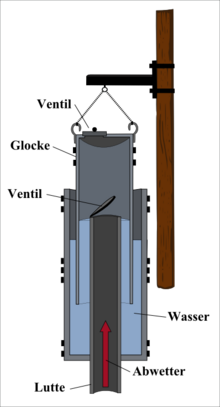Weather rate
A weather set is a machine for artificial ventilation in mining . In terms of its basic structure, it is very similar to an ordinary suction pump. It was mainly used in the Harz mining area .
History and basics
The weather set was invented in 1734 by Schwarzkopf zu Clausthal. Since the weather replacement was invented in the Harz, it is also known as the Harz weather replacement. The Harz weather set, also known as the Patersch weather box, is therefore the oldest weather machine. Weather set to smaller ventilation was used the mine and when drilling of wells . Over the years the weather set has been improved several times. Due to its simple structure, the Harz weather replacement was relatively inexpensive. It was used in some mining districts until the beginning of the 20th century. The weather set was used wherever other ventilation machines were not available. With a weather set, routes with a length of up to 1000 meters could be weathered.
construction
There are two different types of weather set, the single and the double weather set. The simple weather set consists of a fixed and a movable wooden barrel. A tube is attached to the bottom of the fixed outer barrel, which extends far into the barrel. There is a flap valve at the top of the tube. A duct is connected to the lower end of the tube . The smaller, second barrel is mounted in the outer barrel in such a way that it is slipped over the tube and at the same time can also be moved. This second barrel is also known as the bell, it is connected at the top to a sucker rod so that it can be moved up and down. There are two valves on the inner barrel to allow the weather to flow in and out . Depending on the structure of these valves, the weather replacement can work as a weather blower or as a weather vacuum. In the case of the vacuum cleaner, the tube is provided with an outwardly folding valve and in the bell there are inwardly folding valves. In the case of the weather blower, the flap valve on the tube is designed to fold inwards and the valves on the bell are designed to fold outwards. Water is poured into the outer barrel up to below the pipe. The outer barrel is at the top and the inner barrel is open at the bottom. The double set consists of two fixed and two movable barrels. The movable barrels are attached to a beam by means of chains, which is moved by machine power. The rest of the structure of this weather set is the same as that of the simple weather set.
function
Moving the lifting rod moves the inner barrel up and down. Depending on whether the weather set is used as a vacuum cleaner or a weather blower, the valves work accordingly. With the weather vacuum cleaner, a negative pressure is created between the bottom of the inner barrel and the water surface with every stroke of the movable barrel. Due to this negative pressure, the valve on the tube is now opened. This causes the air to flow out of the duct into the cavity of the weather set. The weather from the mine workings then flow into the Lutte. During the downward movement of the inner barrel, this air in the weather set is now compressed. There is a slight overpressure in the weather set, which opens the valves of the inner barrel. This allows the air from the weather set to flow out into the open atmosphere. In the case of a weather blower, the valves in the bell open with every stroke of the bell. As a result, the fresh air flows into the weather set when the bell is raised. As soon as the bell is pushed down by the rod, the valves in the bell close. The air in the bell is now compressed and is pressed through the pipe into the duct and thus blown into the mine workings.
Individual evidence
- ^ A b c Heinrich Veith : German mountain dictionary with evidence. Published by Wilhelm Gottlieb Korn, Breslau 1871.
- ^ A b c d e Johann Heinrich Moritz Poppe: Encyclopedia of the Entire Mechanical Engineering, or complete instruction in practical mechanics and mechanical engineering. Fifth part, by Georg Voss, Leipzig 1810.
- ↑ a b Explanatory dictionary of the technical terms and foreign words that occur in the mining industry, in metallurgy and in salt works, and technical art expressions that occur in salt works. Falkenberg'schen Buchhandlung publishing house, Burgsteinfurt 1869.
- ^ Wilhelm Leo: Textbook of mining science. Printed and published by G Basse, Quedlinburg 1861.
- ^ A b Emil Stöhr: Catechism of Mining Studies. Lehmann & Wentzel bookstore for technology and art, Vienna 1875.
- ↑ Fritz Heise, Fritz Herbst: Textbook of mining science with special consideration of hard coal mining. First volume, published by Julius Springer, Berlin 1908.
- ↑ a b c d e Gustav Köhler: Textbook of mining science. Second improved edition, published by Wilhelm Engelmann, Leipzig 1887.
- ↑ a b c d e f g Wilfried Ließmann: Historical mining in the Harz. 3rd edition, Springer Verlag, Berlin and Heidelberg 2010, ISBN 978-3-540-31327-4 .
- ^ A b Emil Stöhr, Emil Treptow: Basics of mining science including processing. Spielhagen & Schurich publishing house, Vienna 1892.
